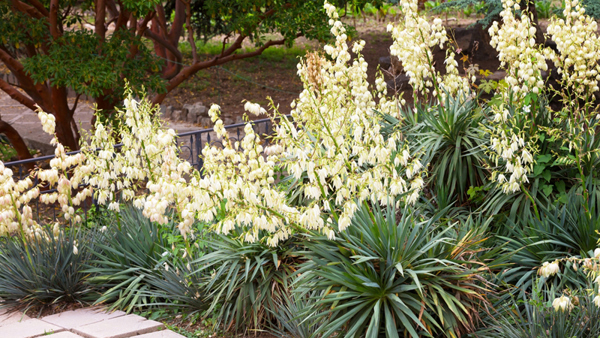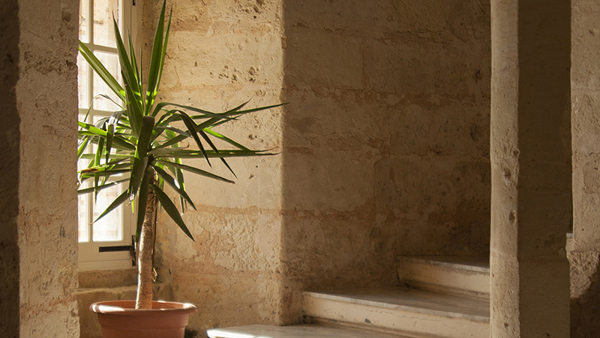Yates Account
Join now
Create a Yates account today!
Sign up to join the Yates Garden Club for monthly e-mails packed with seasonal inspiration, tips for success & exclusive promotions.
Plus if you’re a Garden Club member you can take part in the Yates Growing Community - a blog to share successes, get advice & win prizes in fun challenges along the way!

Forgot password
Enter the email address associated with your account, and we'll email you a new password.

How to grow yuccas in your garden
- Choose a sunny spot with well drained soil. Enrich the soil with Yates Thrive Natural Blood & Bone with Seaweed. In areas with heavy or clay soil, to help improve soil structure and drainage, add gypsum and mix in well.
- Dig the planting hole twice as wide and to the same depth as the root-ball. Remove the plant from the container, gently tease the roots and cut away any circled or tangled roots.
- Position in hole and backfill with soil, gently firming down. Form a raised or doughnut shaped ring of soil around the outer edge of the plant's root zone. This helps keep water where it's needed. Always water in well after planting to settle the soil around the roots and keep the soil moist for several weeks while the new plant establishes.
- Mulch around the base with organic mulch like bark chips, woodchips or pea straw, keeping it away from the trunk.
- Water deeply, once or twice a week, depending on weather conditions.
- Feed in Autumn and Spring with Yates Thrive Natural Fish Seaweed+ Plant Food Concentrate to promote strong root development, healthy colourful foliage and flowers.


How to grow yuccas in a pot
- Pick a variety that can be grown in a pot. Choose a pot at least 500mm wide and deep. Position in full sun.
- Fill chosen pot with quality potting mix, such as Yates Thrive Cacti Succulent Potting Mix. Remove the shrub from the container, gently tease the roots and cut away any circled or tangled roots.
- Position in hole in centre of pot and backfill with potting mix, gently firming down. Water in well.
- Water deeply, once or twice a week, depending on weather conditions.
- Feed in Autumn and Spring with Yates Thrive Plant Food Spikes Cacti & Succulents to promote strong root development, healthy colourful foliage and flowers.
How to grow from cuttings
Ideally spring is the best time to prune and take cuttings from your Yucca. You will need clean, sharp shears or secateurs to prune your plant.
Cuttings are best taken from mature wood. After you take the cutting, remove the lower leaves leaving a few leaves at the top. This will reduce moisture loss from the plant while it is growing new roots. Allow the cutting to dry out for a couple of days in a dry shady spot before potting up. Use Yates Thrive Cacti Succulent Potting Mix.
This will allow the roots to establish easily. In spring the cuttings will develop roots in about 4 weeks. You will need to stake the cuttings to prevent them from falling over. Once the cuttings have established a sufficient root ball, you can then plant them out in the spot where you choose.
Growing tips
- Regularly remove spent leaves and flowers. Plants that grow too tall can have their trunks pruned. This will stimulate new branches to form
- Plants grown indoors will need periods outside to stay healthy, for example 6 months inside then 3 months outside.
- Can be propagated. Take stem cuttings, with leaves removed from the lower 300mm and allow to dry out (in a cool place out of direct sunlight) before planting. They will take up to 6 months to establish. Strike cuttings in Spring to Summer. Plants can also be grown from suckers or from seed.
- The sap of some species can cause skin irritation.
- Some varieties include:
- The spineless Y. elephantipes - in both its plain and variegated forms, has become popular for its architectural shape and its versatility – it can be used both indoors and out, grows to 8m tall in its natural habitat but in home gardens closer to 1.5 - 3m high.
- Y. whipplei – known as ‘Our Lord’s Candle’ grows into a large rosette of very stiff blue-green leaves that after many years bears white flowers.
- Y. filamentosa – known as ‘Adam’s Needle’ is widely grown, especially its yellow or white-margined varieties. It rarely grows more than 1m high.
- Y. aloifolia – known as the ‘Spanish Bayonet’, which reaches 8m high.
- Y. brevifolia – known as the ‘Joshua Tree’ from the southwestern United States, can grow to 12m tall.
This information is from the Yates Garden Guide: fully revised & updated 79th edition, Harper Collins.
















Share
Share this article on social media